[T]hree weapons survive in modern competitive fencing: foil, épée, and sabre. The spadroon and the heavy cavalry-style sabre, both popular in the 19th century, fell into disfavour in the early 20th century, replaced by lighter and faster weapons. The singlestick was featured in the 1904 Olympic Games, but it was already declining in popularity. Bayonet fencing experienced a somewhat slower decline, with competitions organized by some armed forces as late as the 1940s and 1950s.
While the weapons differ in shape and use, their basic construction is similar across the disciplines. Every weapon has a blade and a hilt. The tip of the blade is generally referred to as the point, the top third of the blade as the flexible foible (‘weak in French), while the base of the blade is referred to as “the forté” (or strong part). The hilt consists of a guard and a grip. The guard (also known as the coquille, the bell, or the bellguard) is a metal shell designed to protect the fingers. The grip is the weapon’s handle. In foil and épée the more traditional French grip is approximately straight and usually terminates with a pommel (a heavy nut intended to act as a counterweight for the blade and to hold the handle on the weapon). Some modern French grip designs do not use a heavy pommel nut, in an effort to reduce weight.
The Italian grip, dating from a similar period, has fallen out of general favor. It features a straight handle and a crossbar beneath the guard that the fencer can use to manipulate the blade. The crossbar is known for causing injury, as the fencer’s fingers can become stuck if the blade is turned unexpectedly. It is the only ambidextrous fencing grip, and many fencers with arm trouble use it so they can freely switch without having to carry twice as many blades. The Italian is banned in some regions, and is mistakenly believed to be banned in others, necessitating that users often carry explicit rulings to show judges to prove it is allowed.
The straight grips have been entirely replaced in higher level foil fencing, and partially replaced in épée fencing, by ergonomic designs, called pistol grips or orthopaedic grips. Among the many designs, the most popular are the Visconti, Belgian, and Russian grips, often called ‘standard’. Grips produced by Zivkovic fencing are also popular, and are the most commonly seen ‘non-standard’ grips.
Modern competitive weapons have electrical wiring which allows them to register a touch on the opponent.
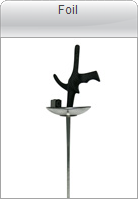 [T]he foil is light and flexible, originally developed in the mid-17th century as a training weapon for the Pariser small sword, a light one-handed sword designed almost exclusively for thrusting.
[T]he foil is light and flexible, originally developed in the mid-17th century as a training weapon for the Pariser small sword, a light one-handed sword designed almost exclusively for thrusting.
Competitive foils have a push-button on the point of the blade, which allows hits to be registered by an electronic scoring apparatus. In order to register, the button must be depressed with a force of at least 4.90 newtons (500 grams-force) for at least 15 milliseconds. Foil and Sabre fencers wear conductive jackets (lamé) covering their target area, which allow the scoring apparatus to differentiate between on- and off-target hits.
The target area is restricted to the torso, including the front and back. When fencing with electrical equipment, the area around each armpit is not covered by the lamé, and is thus not legal.
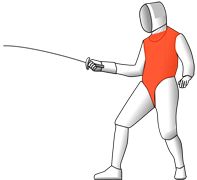 A modification in FIE rules from 1 January 2009 includes that part of the bib below a straight line drawn between the shoulders; prior to this, the bib of the mask was not a valid target. The wisdom of this rule is currently widely disputed. The prevailing attitude in the US is that the rule will lead to more risk due to hits to the throat, while forcing fencers to replace or upgrade their equipment. The European opinion is that the change will help prevent fencers from using the bib to block otherwise legitimate hits. This rule has not been implemented uniformly in all National fencing organizations. European fencing organizations have generally decided on September 1, 2009 as the date for all competitions to use the new rule.[citation needed]
A modification in FIE rules from 1 January 2009 includes that part of the bib below a straight line drawn between the shoulders; prior to this, the bib of the mask was not a valid target. The wisdom of this rule is currently widely disputed. The prevailing attitude in the US is that the rule will lead to more risk due to hits to the throat, while forcing fencers to replace or upgrade their equipment. The European opinion is that the change will help prevent fencers from using the bib to block otherwise legitimate hits. This rule has not been implemented uniformly in all National fencing organizations. European fencing organizations have generally decided on September 1, 2009 as the date for all competitions to use the new rule.[citation needed]
As of September 1, 2009, the USFA had decided not to implement the bib as target for foil. Few hits were actually scored under the new rules in European contests. Domestic competitions in the US do not require the bib target. International events such as Junior or Senior World Cup Events require the bib target.
Foil fencing is conducted using rules of right of way or priority, which determine which fencer’s hit will prevail when both fencers touch. The basic principle is that the fencer who begins an offensive action first prevail over his/her opponent’s hit, unless the initial action fails. A fencer’s action fails when it falls short of his/her opponent, when it misses, or when it is parried. When one fencer’s action fails, the other’s offensive action gains priority.
“Fencing time” limits this priority. A unit of fencing time is the time taken to perform one action at the current tempo of the exchange. The defender must touch within fencing time to avoid losing priority. If priority cannot be determined when both fencers have hit each other, no point is awarded. The original idea behind the rules of foil fencing was to encourage fencers to defend and attack vital areas, and to fight in a methodical way with initiative passing back and forth between the combatants, thus minimizing the risk of a double death.
The target must be hit with the tip of the foil; a touch with any other part of the foil has no effect whatsoever and fencing continues uninterrupted. A touch on an off-target area halts the action, but does not score a point.
When an exchange ends in a hit, the referee will call “halt”, and fencing will cease. The referee will then analyze the exchange and phrase it in official terminology. An example of this terminology would be “Attack from the left, no. Riposte from the right, yes. Point right.”
The first offensive action is called the attack. All defensive actions successfully deflecting an opponent’s blade are called parries. An offensive action of a parrying fencer directly following the parry is called a riposte. An offensive action of a fencer, who attacks a second time without first withdrawing the arm after an unsuccessful first attack, is called a remise. An offensive action of a fencer from the on-guard position, after being parried and then returning to the on-guard position, is called a reprise. An offensive action of a fencer after his/her opponent has lost the right to riposte via inaction is called a redouble. An offensive action begun by a fencer who is being attacked by his/her opponent is called a counter-attack.
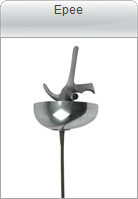 [T]he modern sporting Épée was invented in the second half of the 19th century by a group of French students, who felt that the conventions of foil were too restrictive, and the weapon itself too light; they wanted an experience closer to that of an actual duel. The concept was to create an exact copy of a small sword but without the needle-sharp point. Instead, the blade terminated in a point d’arrêt, a three-pronged tip which would snag on the clothing without penetrating the flesh.
[T]he modern sporting Épée was invented in the second half of the 19th century by a group of French students, who felt that the conventions of foil were too restrictive, and the weapon itself too light; they wanted an experience closer to that of an actual duel. The concept was to create an exact copy of a small sword but without the needle-sharp point. Instead, the blade terminated in a point d’arrêt, a three-pronged tip which would snag on the clothing without penetrating the flesh.
The épée is a thrusting weapon: to score a valid hit, the fencer must fix the point of his weapon on his opponent’s target. The épée target area is the entire body. No rules control the timing of hits. When fencing electronically, fencers do not wear conductive lamé jackets as they do when fencing foil and sabre. In the event of both fencers making a touch within 40 milliseconds of each other, both are awarded a point (a double hit). When the score is equal and the point would mean the win for both, such as in modern pentathlon’s one-hit épée, neither receives a point. Otherwise, the first to hit always receives the point, regardless of what happened earlier in the phase. The épée is the typically heaviest of the sporting weapons, although some épée blades weigh only 150 grams (5.3 oz). An épée is composed of a blade, a point, a bell guard, and a handle or grip (French or pistol grip).
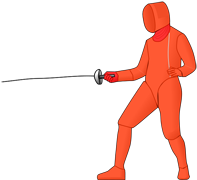 The ‘electric’ épée, used in modern competitive fencing, terminates in a push-button. A hit must arrive with a force of at least 7.35 newtons (1.65 lbf) and the push-button must remain fully depressed for 1 millisecond. All hits register as valid, unless they land on a grounded metal surface, such as a part of the opponent’s weapon, in which case they do not register. At large events, grounded conductive pistes covert the floor to prevent the registration of hits against it. At smaller events and in club fencing, the referee is responsible for noticing floor hits. These often happen by accident, when an épéeist aims at the opponent’s foot and misses. Deliberate floor hits are treated as “dishonest fencing,” and penalized accordingly.
The ‘electric’ épée, used in modern competitive fencing, terminates in a push-button. A hit must arrive with a force of at least 7.35 newtons (1.65 lbf) and the push-button must remain fully depressed for 1 millisecond. All hits register as valid, unless they land on a grounded metal surface, such as a part of the opponent’s weapon, in which case they do not register. At large events, grounded conductive pistes covert the floor to prevent the registration of hits against it. At smaller events and in club fencing, the referee is responsible for noticing floor hits. These often happen by accident, when an épéeist aims at the opponent’s foot and misses. Deliberate floor hits are treated as “dishonest fencing,” and penalized accordingly.
Épée has less restrictive rules for footwork and physical contact than the other two weapons. In Épée, a corps-à-corps (collision between fencers) is not penalized unless initialized with intent to harm or is excessively violent. There are no restrictions on crossing of the feet or use of the flèche attack in épée; if the fencers pass each other, the attacking fencer may score until he passes his opponent. The defending fencer has the right to one continuous riposte, and may still score after the attacker has passed.
The counterattack is very important in épée; direct, unprepared attacks are vulnerable to counterattacks to the hand or arm, or to the body of a taller opponent. High level épée is often a game of provocation, with each player trying to lure the other into an attack. Maintaining the appropriate distance is more important than in the other two genres.
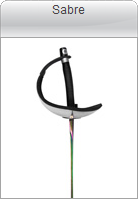 [S]abre is the ‘cutting’ weapon: points may be scored with edges and sides of the blade, as well as the point. Although the modern design with a light and flexible blade (marginally stiffer than a foil blade which bends easily up and down while a sabre blade bends easier side to side) appeared around the turn of the 19th and 20th century, similar sporting weapons with more substantial blades had been used throughout the Victorian era.
[S]abre is the ‘cutting’ weapon: points may be scored with edges and sides of the blade, as well as the point. Although the modern design with a light and flexible blade (marginally stiffer than a foil blade which bends easily up and down while a sabre blade bends easier side to side) appeared around the turn of the 19th and 20th century, similar sporting weapons with more substantial blades had been used throughout the Victorian era.
There is some debate as to whether the modern fencing sabre is descended from the cavalry sabres of Turkic origin, which became popular in Central and Western Europe around the time of Napoleonic Wars, or one of Europe’s indigenous edged dueling weapons, such as the cutting rapier. In practice, it is likely to be a hybrid of the two. Most of the conventions and vocabulary of modern sabre fencing were developed by late 19th century and early 20th century masters from Italy and Hungary, perhaps most notable among them being Italo Santelli (1866–1945).
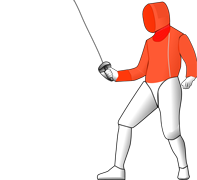 The sabre target covers everything above the waist, except the hands (wrists are included) and the back of the head. Any contact between any part of the blade and any part of the target counts as a valid touch. Earlier conventions stipulated that a valid touch must be made with the point or either the front or back cutting edge, and that a point attack must not merely graze the target and slip along (pass) the opponent’s body. These requirements had to be abandoned, because of technical difficulties, shortly after electronic scoring was introduced into sabre fencing in late 1980s.
The sabre target covers everything above the waist, except the hands (wrists are included) and the back of the head. Any contact between any part of the blade and any part of the target counts as a valid touch. Earlier conventions stipulated that a valid touch must be made with the point or either the front or back cutting edge, and that a point attack must not merely graze the target and slip along (pass) the opponent’s body. These requirements had to be abandoned, because of technical difficulties, shortly after electronic scoring was introduced into sabre fencing in late 1980s.
Sabre is subject to right of way rules and specific definitions of a correctly executed attack and parry. These differences, together with a much greater scoring surface (the whole of the blade, rather than the point alone), make sabre parries difficult to execute effectively. As a result, sabre tactics rely much more heavily on footwork with blade contact kept to a minimum. Play is not halted by an off-target (hands/below the waist) hit in sabre. To prevent both fencers from immediately charging each other at the beginning of fencing action, crossing of the feet is not allowed, which also prohibits use of the flèche. Violations result in a penalty against the offending fencer (a warning, followed by a penalty touch if the offense is repeated). A ‘flunge’ is sometimes used as a replacement for the outlawed flèche: the fencer leaps at the opponent, being sure to keep his rear foot behind his front as long as possible. Safely landing following this move requires crossing the feet, thus the hit must be scored while airborne. Sabre matches are often decided more quickly than the other weapons.